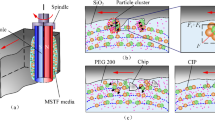Abstract
Magnetorheological finishing (MRF), a precision polishing process, becomes an integral part of optics manufacturing industries for its ability to improve figure and surface finish of complex shape optics without introducing surface damage. It employs magnetically stiffened magnetorheological fluid (MR) ribbon as a flexible polishing tool which moves through the converging gap against workpiece. Material removal characteristic of a polishing tool is described as influence function. Influence function is a parameter to evaluate the efficiency or effectiveness of the polishing process. It provides some useful information for setting up appropriate process parameters to finish different surfaces. Rotational speed of the carrier wheel and gap between the workpiece and magnet are the selected process parameters for studying the influence function. The spot (or influence function) profiles are analyzed to calculate the volume of material removal and depth of the deepest penetration (ddp) using 3D noncontact profilometer. The maximum contribution is made by wheel speed on the volume of material removal and depth of the deepest penetration. To observe the effect of selected parameter setting on the surface topography, final experimentation is performed by employing longitudinal and cross feed and it is perceived that surface generated by cross feed is more uniform.
Similar content being viewed by others
References
Schinhaerl M, Smith G, Geiss A, Smith L, Rascher R, Sperber P, Pitschke E, Stamp R (2007) Calculation of MRF influence functions, Proc. SPIE 6671, Opt Manuf Test VII, 66710Y; https://doi.org/10.1117/12.730806.
Sidpara A, Jain VK (2012) Nano–level finishing of single crystal silicon blank using magnetorheological finishing process. Tribol Int 47:159–166
Tricard M, Dumas PR, Golini D (2004) New industrial applications of magnetorheological finishing (MRF). Frontiers in optics. OSA techndical digest (CD), Paper OMD1. Optical Society of America; https://doi.org/10.1364/OFT.2004.OMD1.
Huang H, Wang BL, Wang Y, Zou J, Zhou L (2008) Characteristics of silicon substrates fabricated using nanogrinding and chemo-mechanical-grinding. Mater Sci Eng A 479:373–379
Shibata T, Fujii S, Makino E, Ikeda M (1996) Ductile- regime turning mechanism of single crystal silicon. Precis Eng 18(2–3):129–137
Hallock B, Dumas P, Shorey A, Tricard M (2004) Recent advances in deterministic low-cost finishing of sapphire windows. Proceedings of SPIE 5786: 154–64
Shorey AB, Jacobs SD, Kordonski WE, Gans RF (2001) Experiments and observations regarding the mechanisms of glass removal in magnetorheological finishing. Appl Opt 40:20–33
Jacobs SD, Arrasmith SA, Kozhinova IA, Gregg LL, Shorey AB, Ramanofsky HJ, Golini D, Kordonski WI, Hogan S (2000) An Overview of Magnetorheological Finishing (MRF) for Precision Optics Manufacturing (Invited Contribution). Ceram Trans 10:185–200.
Arrasmith SR, Kozhinova IA, Gregg LL, Shorey AB, Romanofsky HJ, Jacobs SD, Golini D, Kordonski WI, Hogan SJ, Dumas P (1999) Details of the polishing spot in magnetorheological finishing (MRF). Proc. SPIE 3782, Opt Manuf Test III, 92–100; https://doi.org/10.1117/12.369175.
Sidpara A, Das M, Jain VK (2009) Rheological characterization of magnetorheological finishing fluid. Mater Manuf Process 24:1467–1478
Sidpara A, Jain VK (2011) Experimental investigations into forces during magnetorheological fluid based finishing process. Int J Mach Tools Manuf 51:358–362
Rosenweig RE (1985) Ferrohydrodynamics. Dover, New York
Sidpara A, Jain VK (2017) Magnetorhelogical finishing. In: Jain VK (ed) Nanofinishing science and technology: Basic and Advanced finishing and polishing process. CRC Press, USA
Schinhaerl M, Geiss A, Rascher R, Sperber P, Stamp R, Smith L, Smith G, Pitschke E (2006) Coherences between influence function size, polishing quality, and process time in magnetorheological finishing. Proc. SPIE 6288, Current Developments in Lens Design and Optical Engineering VII, 62880Q1–9; https://doi.org/10.1117/12.678720.
Pitschke E, Schinhaerl M, Sperber P, Rascher R, Stamp R, Smith M, Smith L (2006) Correlation between influence-function quality and predictability of a computer-controlled polishing process. Opt Eng 45(6):063401
Schinhaerl M, Smith G, Stamp R, Rascher R, Smith L, Pitschke E, Sperber P, Geiss A (2008) Mathematical modelling of influence functions in computer-controlled polishing: part I. Appl Math Model 32(12):2888–2906
Schinhaerl M, Rascher R, Stamp R, Smith G, Smith L, Pitschke E, Sperber P (2007) Filter algorithm for influence functions in the computer controlled polishing of high-quality optical lenses. Int J Mach Tools Manuf 47(1):107–111
Schinhaerl M, Schneider F, Rascher R, Vogt C, Sperber P (2010) Relationship between influence function accuracy and polishing quality in magnetorheological finishing. Proc SPIE 7655, 5th International Symposium on Advanced Optical Manufacturing and Testing Technologies: Advanced Optical Manufacturing Technologies, 76550Y
Jacobs SD, Kordonski W, Prokhorov IV, Golini D, Gorodkin GR, Strafford DT (1998) Magnetorheological fluid composition. US Patent 5,804,095
Montgomery DC (2009) Design and analysis of experiments, 7th edn. John Wiley and Sons, Inc
Huang J, Zhang JQ, Liu JN (2005) Effect of magnetic field on properties of MR fluid. Int J Mod Phys B 19:597–601
Sidpara A, Jain VK (2012) Experimental investigations into surface roughness and yield stress in magnetorheological fluid based Nano-finishing process. Int J Precis Eng Manuf 13:855–860
Preston FW (1927) The theory and design of plate glass finishing machines. J Soc Glas Technol 11:214
Sidpara A, Jain VK (2014) Rheological properties and their correlation with surface finish quality in MR fluid-based finishing process. Mach Sci Technol 18:367–385
Sidpara A, Jain VK (2011) Effect of fluid composition on nanofinishing of single-crystal silicon by magnetic field-assisted finishing process. Int J Adv Manuf Technol 55:243–252
Acknowledgements
The authors acknowledge the funding support from the Indian Institute of Technology Kharagpur under ISIRD grant, Board of Research in Nuclear Sciences (BRNS) under young scientist research award (34/20/10/2015/BRNS).
Author information
Authors and Affiliations
Corresponding author
Rights and permissions
About this article
Cite this article
Ghosh, G., Dalabehera, R.K. & Sidpara, A. Parametric study on influence function in magnetorheological finishing of single crystal silicon. Int J Adv Manuf Technol 100, 1043–1054 (2019). https://doi.org/10.1007/s00170-018-2330-1
Received:
Accepted:
Published:
Issue Date:
DOI: https://doi.org/10.1007/s00170-018-2330-1




